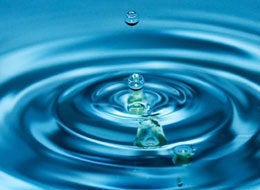
This is Part II of my series on ocean resources, which was initiated with my previous HuffPost on The Coming of OTEC announcing the development of a 10 MW OTEC facility by Lockheed Martin for Honolulu.
Many of you have heard of the Green Revolution, which improved farming practices for grains. The Blue Revolution, while similar in concept, is much more than just a marine copy, for there is promising potential for producing a wide range of sustainable products -- renewable energy, green materials, exciting habitats, marine biomass plantations, next generation fisheries -- while actually improving the ocean environment, through, perhaps, remediating global climate warming and preventing the formation of hurricanes.
Twenty latitude degrees above and below the equator is an ocean region currently considered to be a wet desert, for nothing much grows near the surface. This is because of a lack of nutrients. However, at 1000 meter depths is deep ocean water at 4 degrees Celsius with nitrogen and phosphorous concentrations, for example, respectively, at 100 times and 20 times greater than what is generally found at the surface. This is because life in the photic zone eventually settles at the ocean depths and decomposes in the exact ratio as is required for life at the surface. The deeper ocean is cold because of natural convection from the Arctic and Antarctica. Interestingly enough, marine biomass, certainly in the cellular form, is said to be from two to five times more efficient (in converting sunlight to mass) than any land crop (trees, grasses). Part of the reason is that land plants need to draw nutrients through a root system, while marine life can utilize the entire surface area contacting the ocean.
Natural upwelling brings some of this rich fluid to the surface over only one tenth of one percent of the ocean, where nearly half the seafood is harvested. If a means can be found to bring some of this deep ocean water to the surface, ocean ranches and farms can be supported, which would not need to be fed (the growth cycle would be closed), fertilized or irrigated. Another advantage is that the open ocean is generally considered to be free. The timing is ideal because all fisheries are now reported to be declining, at a time when demand is increasing because of population growth and changing nutritional trends. This resource also offers hope for the production of liquid biofuels and hydrogen. Part 3 of this series will delve into Next Generation Fisheries.
It so turns out that the temperature differential between 1000 meter and surface waters can be utilized to bring huge quantities of water to the surface in a manner which sounds suspiciously like a perpetual motion machine. Ocean Thermal Energy Conversion (OTEC -- see previous posting) has been developed to the stage where net positive electricity can be produced. Hawaii happens to be the site where most of this development has occurred, and the Natural Energy Laboratory of Hawaii Authority is home to more than 30 companies and research organizations supported by deep ocean water. Japan already has a dozen such facilities.
It is the total package of products, though, including seafood, biopharmaceuticals, green materials, biofuels, etc., that appears to have niche applications of commercial interest. In the very long term, there is reason to believe that each grazing OTEC plantship could form a city or, even, country. Chapter 4 of Simple Solutions for Planet Earth(see box on the right) provides details.
In my 2003 Bruun Memorial Lecture to UNESCO in Paris, I proposed that the United Nations take a leading role in galvanizing Project Blue Revolution. There are important Law of the Sea and international political issues to be considered. There are today only 192 countries forming the UN. Someday, perhaps, a thousand OTEC-powered Blue Revolution platforms, each a nation in itself, could well be plying our oceans, providing clean and sustainable resources for Humanity in harmony with the ocean environment.